Teaching Children How to Tell the Time: Hints and Tips
Learning how to tell the time can be a tricky business so we’ve pulled together some hints and tips on how you can support your child to learn this essential skill.
Read on to discover:
- Where to start? We’ll give you some ideas for introducing the concept of time into everyday activities to make time-telling easier.
- Why it’s better to start with an analogue clock rather than a digital one.
- Why you should start counting everything in sight!
- Access to a free demo of Crunch Time, our latest game for some time-telling fun!
So, what’s happening in schools?…
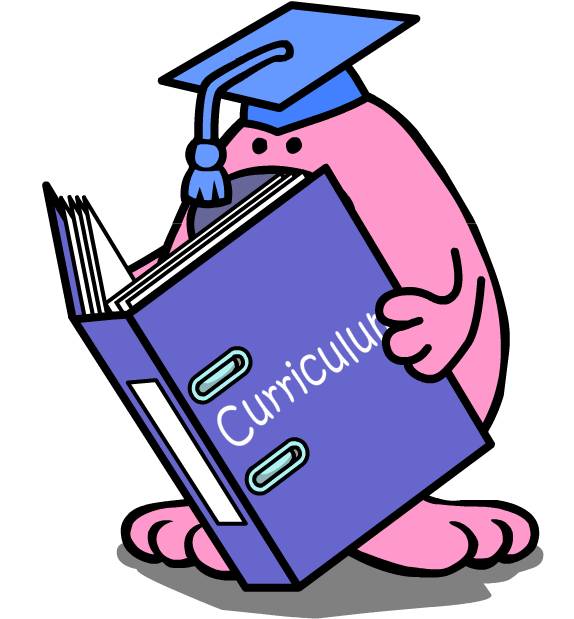
For the first time in England, teaching children how to tell the time has been included within the latest Maths National Curriculum (2014) under the objectives of measures.
To give you a guide on when and how you can encourage and support your child to practice their new skills at home, here are the learning objectives that are being taught in primary schools by year/age…
Year 1 (ages 5-6): Pupils should be taught to:
- Tell the time to the hour and half past the hour and draw the hands on a clock face to show these times.
Year 2 (ages 6-7): Pupils should be taught to:
- Tell and write the time to five minutes, including quarter past/to the hour and draw the hands on a clock face to show these times.
- Know the number of minutes in an hour and the number of hours in a day.
Year 3 (ages 7-8): Pupils should be taught to:
- Tell and write the time from an analogue clock, including using Roman numerals from I to XII, and 12-hour and 24-hour clocks.
- Estimate and read time with increasing accuracy to the nearest minute; record and compare time in terms of seconds, minutes and hours; use vocabulary such as o’clock, a.m./p.m., morning, afternoon, noon and midnight.
Year 4 (ages 8-9): Pupils should be taught to:
- Read, write and convert time between analogue and digital 12- and 24-hour clocks.
Introducing the concept of time

We came across a comedy sketch by Dave Allen on You Tube – teaching your kid time, it includes this line describing time; “One is five, two is ten, six is half – because 12 is the whole” … An amusing and timely reminder not to underestimate the complexity of time and how baffling this concept must be for a child!
So, to make this crazy concept make some sense it needs to be brought into everyday life. As we know, children learn best when they’re having fun so anything you can do to incorporate time into everyday activities that your child enjoys will make the process much easier – introduce one concept at a time, use a mix of resources and a variety of fun techniques to keep things interesting.
Here’s some ideas to try…
Break it down
You can then move on to asking your child when certain things happen – this starts off the idea of blocking time into sections. Why not incorporate story books with a time theme into your bed-time routine too.
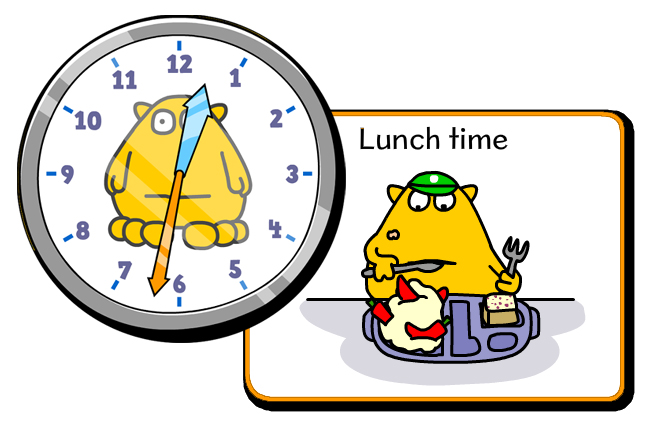
Get to grips with time duration
You could make a point of timing some of your child’s favourite activities to help them connect more with the passage of time – do some baking together and set the oven timer, announce that their programme will be on the TV in 10 minutes and set an alarm or stopwatch.
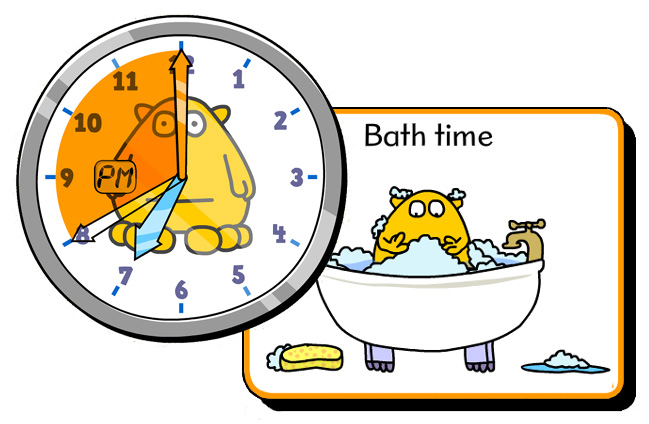
Reading clock-faces – don’t jump in with digital
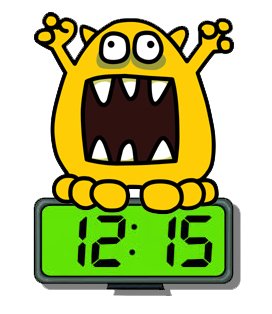
Analogue clocks lend themselves to the better understanding of time because of the constantly moving hands. The visual impact of the clock face also makes comprehension easier i.e. seeing the sections of the clock and matching this to counting in 5 minute intervals.
Top Tip: If your child has a digital clock in their room, it may be worth considering changing it for a traditional clock face. Perhaps you could let them pick a new watch as an opportunity for them to engage with their new challenge!
Here’s how you can start practising…
Once these basics are established, let your children remind you when it is time to do something… You may well find that they will pick this up especially easily if it’s something they’re really looking forward to, perhaps not so quickly if you’ve asked to be reminded when it’s time for bed!
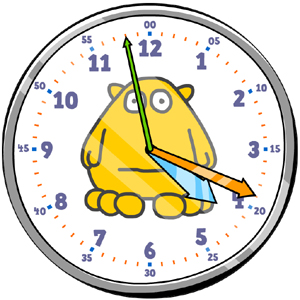
We have created a Clock widget to help aid discussions and encourage experimentation, learn more about our interactive clock.
You could make a paper plate clock with movable pipe-cleaner hands as a fun project to bring your clock-face to life; there are plenty of templates for this available online or download our make-a-clock PDF below….
The fact that Roman numerals also translate to numbers on a clock can also be a tricky thing for children to understand so include both on your paper plate clock as seeing them alongside each other will help.
Busythings News! We have just introduced a fun new game, Crunch Time to help with the practice of clock-reading skills. Click here to learn more about our telling the time game!
Why counting is essential for learning how to tell the time
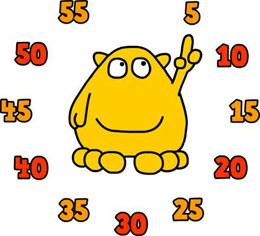 To help the process of learning how to tell the time, it is essential for children to be able to count from 1 to 60 in the correct order.
To help the process of learning how to tell the time, it is essential for children to be able to count from 1 to 60 in the correct order.
Double-digit numbers can be particularly difficult to remember in the right order so try to introduce counting into everyday life as much as possible – point out numbers wherever you see them and ask your child to repeat the numbers back to you.
Once you’ve cracked 1-60, move on to counting in groups of 5 – remember to point out that when you count in fives, every number ends in a 5 or 0. The rhythm in songs can help to make this more fun! There are many songs available on You Tube to bring the 5 times table to life. When your child is comfortable with this, start pointing to the numbers on a clock face as you sing along to tie the two things together.
Here’s a fun sketch from The Chuckle Brothers explaining how to read the time on an analogue clock to the nearest 5 minutes.
Telling the Time – In summary:
As part of the new National Curriculum, your child will be learning how to tell the time at Primary School – we have given you details of the objectives set for each Primary year.
Equipped with this knowledge, you can now provide fun opportunities for your child to practise their new skills at home in a timely fashion:
- Remember, telling the time can be tricky to grasp – take it one step at a time.
- Begin by introducing the general concept of time into your everyday conversations.
- Start practising with an analogue clock-face and incorporate telling the time into everyday activities.
- Counting is essential for time-telling – the more comfortable a child is with counting from 1 to 60 and the 5 times table, the easier telling the time will become.
Ultimately every child learns differently and at a different speed, try different activities and techniques – just keep it fun and rewarding. Reinforce concepts of time during your everyday routines and they will be confident in no time!
Click below to download your make-a-clock PDF…
We hope that you have found our hints and tips for teaching children how to tell the time useful. Please leave a comment; we’d love to hear what time-telling ideas have worked for you?
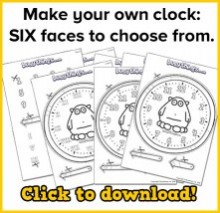

19 Replies to “Teaching Children How to Tell the Time: Hints and Tips”
Heya.
A clock is a great idea in order to start with. Alternatively you could get them to calculate arrival and departure times of trains. Another option is to make up ten questions using real life situations. Good luck.
For example time required to make up some party cakes. You can even have the kids answer questions on match times or time in general. You can even make up questions using a clock to teach movie times. Yet more options include lesson times and eating times. Questions on time must be made fun. Picnic and event times are other possibilities.
Great suggestions, thank you
I love these tips! The digital clock can really be tempting, but better to start with the basics. Thank you for sharing this
I’m so excited
Excellent recommendations and guidelines! We’ve found that audio books, ebooks and apps can also be beneficial to building skills and fostering a love of reading.
You’ve hit the nail on the head,Thanks
I love this blog! A lot of good info and well structured. Another one I can recommend is https://www.todaysparent.com/kids/school-age/fun-ways-to-teach-kids-to-tell-time/
A well-written, insightful article indeed! Thank you for sharing. Like your practical, easy-to-follow guide on raising a happy and successful child. Must share it with all my friends.
very helpful guideline for teaching how to tell the time regarding different junior age groups. I really appreciate your tips. Thanks a lot.
Good article. Some other thoughts…
I have had moderate success teaching 4–5 year olds to read a clock. This is an age that typically has limited or no experience at all with math, which is essential in reading a clock as adults do (counting by 5’s and 10’s). The first thing to establish with a child is recognizing the hands on a clock. Obviously one is bigger than the other and the two hands mean completely different things… however, it is possible (and actually effective with kids so young) to learn how to tell time with the hour hand alone.
Thank you for this article, you’ve got great ideas here for parents. I’m sure I can do this in addition to what the child is taught at school. I’ve shared this on facebook with my friends
Thanks for this awesome article, I read many articles on this topic. You can read this one also, It will be also beneficial to Parents: https://megaeducare.wordpress.com/2017/01/18/handful-tips-to-teach-child-to-tell-the-time/
This is a great list of ideas. Learning to tell time and keep on a schedule will help you child dramatically. Thanks for this great advice on teaching kids to tell time!